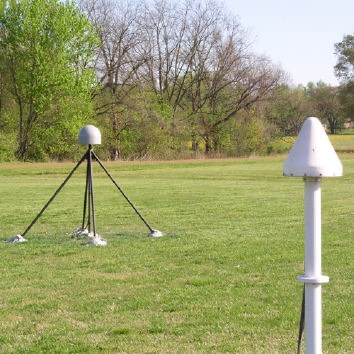Large earthquakes within stable continental regions show that significant amounts of elastic strain can be released on geological structures far from plate boundary faults, where the vast majority of the Earth's seismic activity takes place. The 1811-1812 New Madrid events in the Mississippi valley are classical examples of large intraplate earthquakes (e.g. Nuttli, 1983; Johnston, 1996; Hough et al., 2000).
Because significant intraplate earthquakes are infrequent and the strain rates are so low, neither the rates and pattern of intraplate strain are well constrained, nor are the mechanism(s) responsible for strain accumulation and release on faults inside plates. Unlike plate boundary faults, where far-field plate motion and near-field strain are clearly related, such a relation between far- and near-field motions is not established for plate interiors. Far-field plate motions may contribute to the stress balance that loads seismogenic faults, but other stress sources such as density anomalies in the lower crust or glacial isostatic adjustment and local parameters such as high pore fluid pressure, weakness of pre-existing faults, or density anomalies in the lower crust may contribute equally significantly to the stress budget.
Over the past decade, GPS has become an invaluable tool for measuring long-term plate motion and strain accumulation on active faults. In areas of rapid strain accumulation such as the western United States, GPS-derived estimates of strain have been used effectively to help estimate earthquake hazard. In areas such as the Central and Eastern US, where rates of strain accumulation are slower than ~1 mm/yr, measuring strain from GPS has proven to be significantly more challenging, requiring additional attention to GPS monument stability and the effects of random and correlated sources of errors in GPS station velocities. A better understanding of deformation within plates thus requires geodetic measurements over long periods at both local and plate-wide scales, combined with rigorous attempts to extract the maximum precision from those observations.
The mechanical behavior — hence earthquake potential — of faults in continental interiors is a question of critical importance for the resultant seismic hazard, but no consensus has yet been reached on this controversial topic. The debate has focused on the central and eastern United States, in particular the New Madrid Seismic Zone, struck by three magnitude 7 or greater earthquakes in 1811-1812, and to a lesser extent the Wabash Valley Seismic Zone just to the north. A key aspect of this issue is the rate at which strain is currently accruing on those plate interior faults, a quantity that remains debated. We address this issue with an analysis of up to 14 years of continuous GPS data from a network of 200 sites in the central United States centered on the New Madrid and Wabash Valley seismic zones. We find that all the high quality sites in these regions show motions that are consistently within the 95% confidence limit of zero deformation. These results place an upper bound on strain accrual on faults of 0.2 mm/yr and 0.5 mm/yr in the New Madrid and Wabash Valley Seismic Zones, respectively. For the New Madrid region, where a paleoseismic record is available for the past ~5,000 years, we argue that strain accrual — if any — does not permit the observed 500-900 year repeat time of paleo-earthquakes in the Upper Mississippi Embayment. These results, together with increasing evidence for temporal clustering and spatial migration of earthquake sequences in continental interiors, indicate that either tectonic loading rates or fault properties vary with time in the NMSZ and possibly plate-wide.
